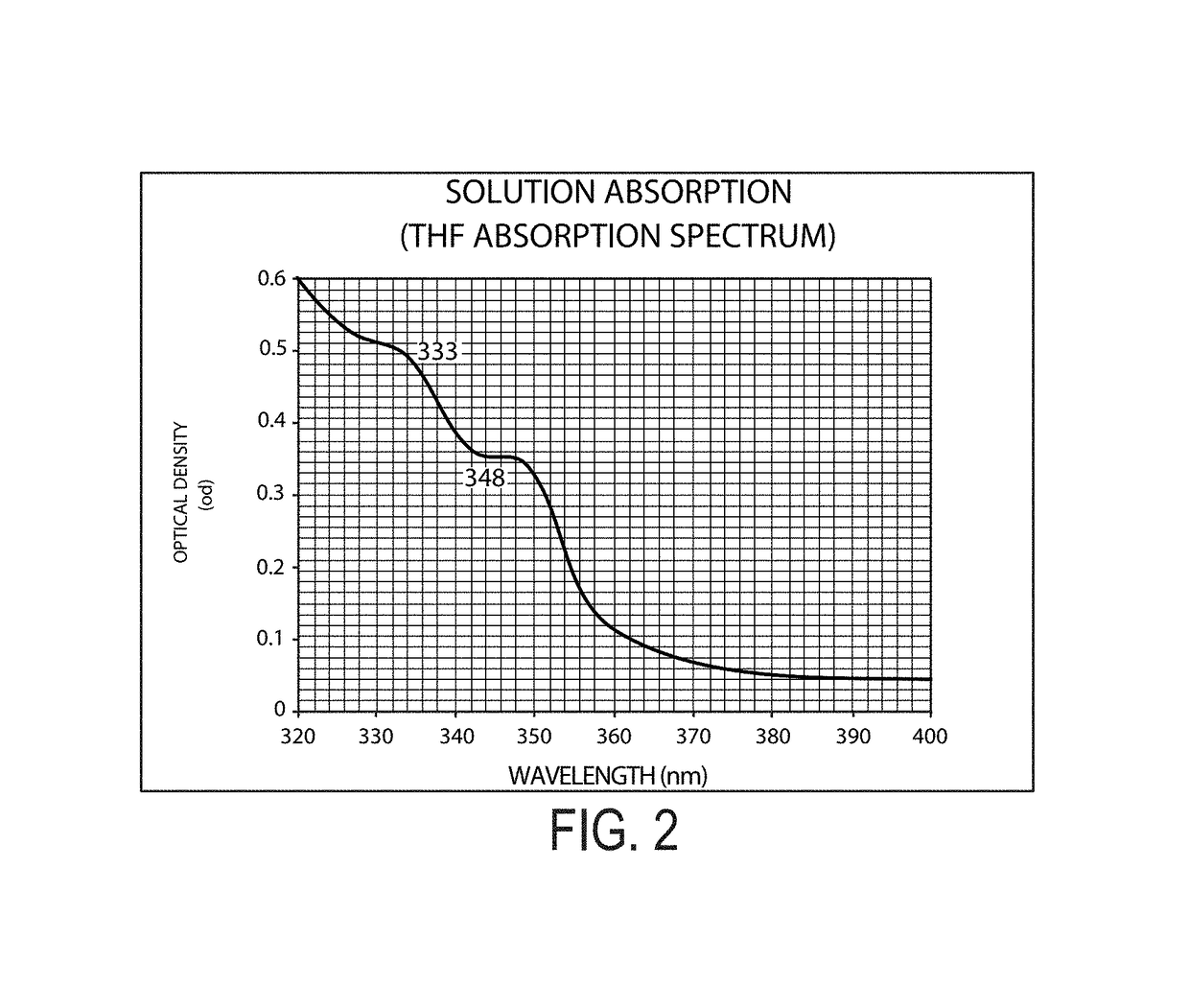Charge-transporting molecular glass mixtures, luminescent molecular glass mixtures, or combinations thereof or organic light emitting diodes and other organic electronics and photonics applications
a technology of molecular glass and molecular glass mixture, which is applied in the field of molecular glass, can solve the problems of limiting device longevity, degrading the performance of the device comprising the non-equilibrium molecular glass, and still affecting the crystallization process, etc., and achieves good film forming properties, low melt viscosity, and high entropy of mixing. large
- Summary
- Abstract
- Description
- Claims
- Application Information
AI Technical Summary
Benefits of technology
Problems solved by technology
Method used
Image
Examples
example 1
arbazole-Oxadiazole Molecular Glass Mixture
[0482]
TABLE 2Optical, Photophysical PropertiesMolecularμelectronμholeGlass Mixtureλabsa / nmλabsb / nmλemc / nmEcg / evEdg / evcm2 / Vseccm2 / VsecExample 1333 / 348377 / 420 (347 ex)3.43Example 2238 / 265 / 296240 / 285 / 320368 (295 ex)3.433.294.8 × 10−44.8 × 10−4aIn THFbNeat Filmcin THFdNeat Film
[0483]
TABLE 3Thermal PropertiesMolecular Glass MixtureTge / ° C.Tsch / ° C.Tm / ° C.Td / ° C.Example 180nonenone275Example 2150202.7291.6320e) @ 10° / min
[0484]Thermal Properties
[0485]Referring to the graph depicted in FIG. 4, differential scanning calorimetry (DSC), shows no crystallization peak (Tsch), no melting point peak (Tm), and a well defined glass transition temperature (Tg) at 80° C. even after four heating cycles up to 200° C. above the glass transition temperature. This clearly shows that the molecular glass mixture is noncystallizable. The Tg of this molecular glass mixture (80° C.) is 15° C. above that of TPD (N,N′-diphenyl-N,N′-bis-3-methylphenyl[1,1′-bipheny]-4,4′-d...
example 2
on of Bipolar Oxadiazole-Carbazole 3,3′,4,4′-Biphenyltetracarboxilic Bisimide Molecular Glass Mixture
[0499]
[0500]In a 250 milliliter three-necked round-bottomed flask, fitted with a condenser were added 150 ml of anhydrous NMP solvent. Then 2.22 g (0.01163 mole) of recrystallized 2-Amino-5(4-methoxyphenyl)-1,3,4-oxadiazole, 7.34 g (0.0349 mole) of recrystallized 3-amino-9-ethylcarbazole, and 1.87 g (0.011636 mole) of recrystallized 2-Amino-5-phenyl-1,3,4-oxadiazole, 8.56 g (0.02908 mole) of recrystallized 3,3′,4′-Biphenyltetracarboxilic di-anhydride, and 7.51 g (0.05816 mole) of isoquinoline (catalyst) were added.
[0501]The mixture was gently heated to 70° C. under stirring for 2 hours, followed by refluxing for 5 hours. Thereafter, the reaction solution was poured into a mixture of methanol and dilute hydrochloric acid under vigorous stirring, giving a molecular glass powder. The molecular glass was filtered, re-dissolved in NMP and re-precipitated into a mixture of methanol and dis...
PUM
| Property | Measurement | Unit |
|---|---|---|
| Tg | aaaaa | aaaaa |
| boiling point | aaaaa | aaaaa |
| temperature | aaaaa | aaaaa |
Abstract
Description
Claims
Application Information
 Login to View More
Login to View More - R&D
- Intellectual Property
- Life Sciences
- Materials
- Tech Scout
- Unparalleled Data Quality
- Higher Quality Content
- 60% Fewer Hallucinations
Browse by: Latest US Patents, China's latest patents, Technical Efficacy Thesaurus, Application Domain, Technology Topic, Popular Technical Reports.
© 2025 PatSnap. All rights reserved.Legal|Privacy policy|Modern Slavery Act Transparency Statement|Sitemap|About US| Contact US: help@patsnap.com



